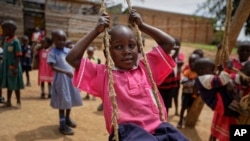Daniel Byamukama, the head of HIV prevention at the Uganda AIDS commission, says “from the age of 15 to the age of 34, the HIV prevalence in women increases rapidly, which shows that during those young ages those young women are contracting HIV.
Officials at the commission say more than 50,000 people, mainly women, contracted HIV in the past year.
"We recently did a mode of transmission HIV study for the whole country. We find that in every culture the number of new HIV infections are highest among adolescent girls and young women — more than the key populations,” Byamukama told VOA.
Key populations who are most likely to be exposed to HIV or to transmit HIV include commercial sex workers, people who inject drugs, prisoners and other incarcerated people.
Byamukama says gender-based violence as well as some cultural beliefs make women more prone to HIV infections.
Gloria Nawanyanga, a young person living with HIV in Uganda, says many communities shy away from talking about sex.
"So many people don’t want talk about HIV because they see it as an abomination," she said. "They don’t want to talk about sex because it’s something that is not supposed to be talked about, but at the end of the day young people are very adventurous and they want to find out what it is like.”
Nawanyanga, who was born with HIV, says she often faces stigma and discrimination.
She says most of her peers refuse to test for the disease or seek medical advice regarding it because they fear they will be ostracized.
Musician and HIV activist Joanita Kawalya says social rejection is common.
She told VOA she is mobilizing fellow musicians to use songs and other art forms to educate the public, mainly young people, about reproductive health as well as HIV-AIDS.
“If we fear to talk about it for them, they don’t know. They just keep trying and they end up (with) a problem," Kawalya said. "Then, (there's) the poverty: people are poor … the needs of young people and the environment where they live determines very much what they are going to be in life.”
Daniel Alemu, head of United Nations Population Fund, says that is why it is important to invest more in prevention and treatment activities that focus on everyone in society.
“Whether it is young girls, whether it is key populations, whether it is people with disabilities," he said, "we have a specific responsibility toward these populations, and we have to ensure that we create a conducive legal and social environment free of stigma and discrimination to allow the continued unhindered access to services.”
At least 1.4 million people live with HIV in Uganda.
The government has set a target of reducing new HIV infections by 65% by 2025 and to get to zero new cases by 2030.


Forum